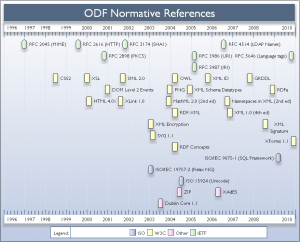I think you will enjoy this graphic. Click for a larger view. This is a chart of all of the standards that ODF 1.2 refers to, what we standards geeks call “normative references”. A normative reference takes definitions and requirements from one standard and uses it, by reference, in another. It is a form of reuse, reusing the domain analysis, specification and review work that went into creating the other standard. Each reference is color coded and grouped by the organization that owns the referenced standard, W3C, IETF, ISO, etc., and placed on a time line according to when that standard was published
I’m sure each reader will note interesting patterns on their own, but a few things stood out in my mind when looking at this chart:
- ODF is very much built on top of web and internet standards from the W3C and IETF. That is where the bulk of our references are from. This is true not only of the older stuff from the web’s initial standardization effort in 1998-2000, but also for more recent work like GRDDL, RDFa and XForms 1.1. As documents start living more of a dual-life, on the desktop and on the web (and even mobile), this web standards heritage of ODF will continue to open new doors for ODF implementors and users.
- Except for a few bedrock standards like Unicode, ISO just doesn’t register. They simply are not doing a lot of relevant work in this area.
- A good response when you are faced with critics who claim that ODF is just based on what OpenOffice.org does. You can point out that OpenOffice was first released as open source in 2000 and via StarOffice had a proprietary history going back to 1984. So if ODF is merely a dump of what OpenOffice does, then why is ODF built on so many standards that did not exist in 2000? Does time travel explain it? Or maybe clairvoyance? Or maybe, just maybe it is just good engineering to reference relevant standards in your domain rather than reinvent a proprietary version of everything?

A) The larger view of chart, “ODF Normative References”, is a bitmapped image. If there is and SVG or ODF version available, it would be very useful to have available for re-use in presentations or other publications.
B) Nice points, Rob. The ‘critics’ do sum up to one group consisting of a vendor we need not name and its boosters. The ‘criticism’ does sum up to one tactic, which is most famously described thus:
“If you tell a lie big enough and keep repeating it, people will eventually come to believe it. The lie can be maintained only for such time as [Little and Soft] can shield the people from the political, economic and/or military consequences of the lie. It thus becomes vitally important for [Little and Soft] to use all of its powers to repress dissent, for the truth is the mortal enemy of the lie, and thus by extension, the truth is the greatest enemy of [Little and Soft].”
That works as long as too many of the general populace are unable or unwilling to discern between empirical facts and wishful thinking. Making science, or even knowledge, popular is one solution.
If you notice, the ‘critics’ recycle their material every other year or so. David A Wheeler addressed in 2008 and 2006 some of the same issues you address now in 2010 and shot down some of the same disinformation in his essay “Is OpenDocument an Open Standard? Yes!”
http://www.dwheeler.com/essays/opendocument-open.html
Part of the ‘critics’ strategy is to keep moving the discourse backwards a few steps or even back to square one. Resources could be spend moving forward if it were enough to shut out the individuals involved or at the minimum shut down the revisionism as such. Old business is old business. There is a time and a place to discuss old business. There is a time and a place not to.
http://www.robertsrules.com/
I agree that a vector format like SVG would be preferable. Unfortunately the software I used to make this (Timeline Maker) only exports bitmap formats. I know this could be drawn by hand in something like Inkscape, but this is quite laborious compared to an application that will automatically place the data according to date. If you know of a better program for creating such a chart, let me know.
Here is the underlying data you can use:
CSS2,May 12 1998,W3C
Dublin Core 1.1,Jun 02 2003,Other
HTML 4.01,Dec 24 1999,W3C
MathML 2.0 (2nd ed),Oct 21 2003,W3C
RFC 2616 (HTTP),Jun 15 1999,IETF
ISO/IEC 19757-2 (Relax NG),Dec 12 2002,ISO
SMIL 2.0,Aug 07 2001,W3C
SVG 1.1,Jan 14 2003,W3C
XForms 1.1,Oct 20 2009,W3C
XLink 1.0,Jun 27 2001,W3C
Namespaces in XML (2nd ed),Aug 16 2006,W3C
XML 1.0 (4th ed),Sep 29 2006,W3C
XSL,Nov 16 1999,W3C
DOM Level 2 Events,Nov 13 2000,W3C
GRDDL,Sep 11 2007,W3C
ISO 15924 (Unicode),May 29 2004,ISO
OWL,Feb 10 2004,W3C
RDF Concepts,Feb 10 2004,W3C
RDFa,Oct 14 2008,W3C
RFC 2045 (MIME),Nov 15 1996,IETF
RFC 4514 (LDAP Names),Jun 15 2006,IETF
RFC 5646 (Language tags),Sep 15 2009,IETF
ISO/IEC 9075-1 (SQL Framework),Jan 27 2009,ISO
XML Schema Datatypes,Oct 28 2004,W3C
XML Encryption,Dec 10 2002,W3C
XML ID,Sep 09 2005,W3C
PNG,Nov 10 2003,W3C
RDF-XML,Feb 10 2004,W3C
RFC 2898 (PKCS),Sep 15 2000,IETF
RFC 3174 (SHA1),Sep 15 2001,IETF
RFC 3986 (URI),Jan 15 2005,IETF
XML Signature,Jun 10 2008,W3C
ZIP,Apr 26 2004,Other
XAdES,Mar 07 2006,Other
RFC 3987 (IRI),Jan 15 2005,IETF